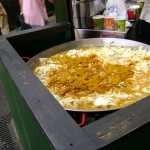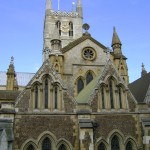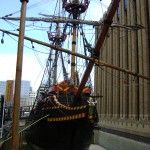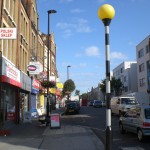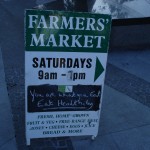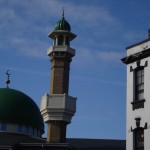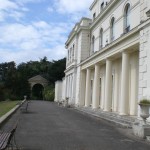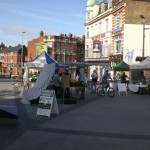Entries from August 2009
Ever since I took a Museum Studies class at Dickinson, I appreciate exhibitions in a whole different way than I used to. Today I visited the Museum in Docklands, which covers London’s history from its creation, to the present day, particularly focusing on the port as a key element to understand the city’s relationship with the rest of the world.
When I walk into a museum, I try to find the “script” or the underlying message in the exhibit, that is, why are the objects arranged in a particular way and what is the ideology that is being articulated through this arrangement? In the museum I went today, I paid particular attention to the gallery or section entitled “London, Sugar and Slavery”. Apparently, this museum is the only one in London that has a permanent collection that examines the capital’s involvement in the transatlantic slave trade.
The information on the exhibit was extremely interesting and I discovered there was much I did not know about the slave trade. But what I thought was most interesting was the way slavery was explained. First, I can imagine that a museum actually acknowledging the atrocities that were committed by Great Britain to its colonies, is a relatively new phenomenon. I believe it is very positive that the museum focuses on the slave trade instead of showing the greatness and opulence of the British empire, which was precisely built upon the suffering of millions. This always happens to me when I am in a rich European capital. Coming from Latin America, I am aware of how much Europe is to blame for the history of the countries that are now called the Third World. For example, when I was in Spain, whenever I saw an ostentatitous building painted in gold (most of the time they were Churches) I would think: How many people had to die in the mines of Bolivia so that this place would look like this? The same thing happens to me at the British Museum when looking at all the historical objects that were blatently stolen from other countries.
A second aspect of the Museum in Docklands that I observed was the very clear importance of political correctness in the making of the gallery. For example, there was a large wall sign explaining how the museum was particularly careful with the terminology used when referring to slaves, black people or white people. Instead of using the term “slave” they used “enslaved African”, or “European people” instead of “white people”. Third, what I thought was an extremely important piece of information for understanding slavery, was the explanation by Caribbean historian Eric Williams on how slavery was abolished not really because people at the time thought it was morally wrong but because they discovered that it was not longer profitable! Apparently the monopoly of the big slave trading companies where obstacles for free market and the further economic growth of Great Britain. It was clear that every aspect of the exhibition aimed at acknowledging a mistake and judging history. One painting that struck me was a portrait of the most important owner of a plantation in Jamaica, which the museum chose to put next to a title that said “Slave Owner”, instead of writing the man’s name. But the exhibit went even further, so much to the point that there was a projection in which the words that were one pronounced by slaves were now being mouthed by people from different ethnicities, which could lead to the idea that, either some people in London today are suffering almost as much as slaves used to. At the same time, the short film could stand for the idea that every London should be aware of the dark history on which the city was built upon.
More and more, museums have become tools to rectify history, to articulate the government’s mea culpa. I believe the Museum of Docklands is one example of this phenomenon.
Tags: Azul
Our Roman Wall tour through the City of London this morning opened my eyes to just how great a stamp the Romans left on not only the British Isles as a whole, but the city of London itself. Previous to this walk, I had been under the impression that once they pulled out the only things of Italian origin left in the city were those that had been built specifically by the legions in residence. Perhaps I should have considered that the Romans had been occupying this piece of land for several centuries, much longer than living memory, and so their architecture and culture were all the citizens of Londinium knew. Of course they would have continued to build in the style to which they were accustomed. Despite the Norman conquest in 1066, the city’s Roman roots continue to show through. Several buildings, most notably churches, in the area of Old London are blatently Roman in design. One goes so far to look remarkably like the Pantheon from the front, despite the steeple rising in the back. Even Christopher Wren’s memorial to the Great Fire looks remarkably like the Column of Trajan in Rome, complete with internal stairs and a overlook. And these buildings are not the
-
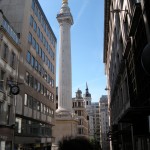
-

left overs of the Roman occupation, but rather creations of the 16th and 17th centuries, and while we no longer see forums or bath houses, we only need to look to realize that the founders of this city are not as distant as we thought.
Tags: Campbell
This afternoon, my group and I found our way to the Docklands Museum near Canary Wharf. We encountered some trouble en route when our DLR conductor announced the train would not be stopping at West India Quay. We got off at Westferry and a friendly gentleman on the platform pointed us in the right direction. As his directions weren’t entirely clear, we had to ask two other people where to go along the way. Astonishingly, we didn’t get lost and all 13 of us made it there with time to spare.
The museum as a whole was by far the most enjoyable of the museums I’ve visited so far. The exhibits started on the third floor with Roman London and moved on chronologically down to the first floor. Unlike the London Museum, the path through the exhibits was clear and easy to follow. There was a good mix of the typical museum voice narrative to read on the wall, which provided important information about the both the time period and the artifacts displayed, and interactive media, which provided more in-depth histories. Additionally, experiential pathways that recreated parts of London helped visitors to understand (through sight, sound, and smell!) what various parts of the city were once like. My favorite of these recreations was Sailortown, which takes one through the winding streets of Wapping in the mid 19th century past “the wild animal emporium,” the “ale house,” and the “sailors’ lodging house.”
The most engaging of the galleries was “London, Sugar & Slavery,” an exhibit about London’s role in the Atlantic Slave Trade. After taking “The Atlantic Slave Trade and Africans in the Making of the New World,” with Professor Ball last semester, I was especially interested in seeing how the museum’s perspective compared to those taught in the class. Surprisingly, the first sign that caught my attention was one toward the beginning of the gallery entitled: “Terminology.” This sign made visitors aware of how the museum intended to use specific words. For example, the museum emphasized that it would use “enslaved Africans” instead of “slave,” as “slave” is a more dehumanizing words. The sign also defined vocabulary words the average visitor might be unfamiliar with. I’ve never seen anything similar to this in American museums. Terminology is an important process in the exhibition development process, as I learned this summer during my internship at the 9/11 museum in Manhattan. Especially for sensitive topics, it is important that the terminology be deliberate and exact. I was impressed that the museum chose to tell its visitors right up front precisely how words would be used in attempt to avoid any misunderstanding or misinterpretation. This reminds me of many scholarly articles I’ve read where historians choose to clarify vocabulary for the reader before jumping into denser material and analysis.
The only part of the Slavery gallery that I noticed disagreed with what I had previously learned was a sign describing the “Triangle Trade” model for explaining how the Atlantic Slave Trade Operated, which involves ships leaving from Europe, picking up slaves in Africa, then sailing to the Americas, selling off their slaves, and returning to Europe h sugar and rum. Due to numerous circumstances, the slave trade was not so simple. Just for one example: slaves ships were specifically designed to carry human cargo; therefore, it would be impractical to use the same ships to transport both slaves and rum on the same vessel. However, I do understand why the museum would choose to use this model (as do most middle and high schools in the U.S. It is basic and easy to understand. The model gives a general idea of what happened, but avoids some of the grittier details.
Finally (whew!), I found the collection of comment cards about the Slavery gallery to be rather interesting. There was a shockingly wide range of reactions. Some people loved it and others absolutely HATED it. There were some comments that other guests chose to respond to. Many of the negative comments read along the lines of: “The slave trade isn’t my fault, so why should I care?”; “This isn’t London. What about all of the white workers who lived in terrible conditions?”; and “This is crap. I’m never coming to this museum ever again.” Some of the more positive responses included those commenting on the importance of treating all human beings as equals and working to fight the injustices that exist today. One particular comment that sticks in my mind was left by a person who felt the exhibit didn’t successfully address the sheer brutality of the slave trade. This, too, reminded me of some of the issues faced at the 9/11 museum. As 9/11 is such a recent and traumatic event, the museum often has to make decisions about what information is historically necessary and what is simply gruesome and voyeuristic. Finding a balance of between representative and appropriate is a daunting task.
Tags: Museums · Sarah
After a bit of trouble navigating the DLR (apparently the train we got on didn’t happen to stop at West India Quay, despite what it said on the map), all thirteen of us arrived at the Docklands Museum after a bit of a hike between the DLR stop we got off at and the DLR stop we were supposed to arrive at. I must admit we were all rather tired and “museumed out” after our walking tour and our trip to the London Museum earlier, but we quickly realized that the Docklands Museum had a lot to offer.
The London Sugar Slavery Gallery exhibit stuck with me the most. I tend to automatically think of slavery as an American phenomenon, something tied in with American plantations and Abraham Lincoln and the Civil War, but it was interesting to see the more urban lives of the British African slaves, as well as the fact that many slaves (and later, indentured servants from China and India) were sent to the British-owned sugar plantations in the West Indies. Strolling through the exhibit, I thought it was well done, with equal attention paid to the lives and conditions of the slaves, the Abolishionist movement, and the influence slaves’ work today.
However, upon coming to the end of the exhibit, I was surprised to discover that many visitors to the museum did not find the exhibit satisfactory and were so displeased that they felt the need to leave notes, which the museum had collected into a binder. Several commenters thought the exhibit was a waste of space, since the slave trade and its inhumanity were not the commenters’ faults and they claimed they didn’t need to apologize for it. Others thought the slaves’ plight wasn’t documented graphically enough and that the exhibit glossed over the conditions they lived in and the treatment they faced. Still others were disappointed that the museum had chosen to devote so much space to the slave trade and not as much to British innovators and historical figures. After reading through many of the comments, several of us sat around discussing the complaints and why we found the commenters’ arguments to be inadequate.
Firstly, many of us felt that the fact that the sheer amount of artifacts, quotes, artwork, and lasting influence on today’s British culture merited the inclusion of the exhibit into the Docklands Museum, and that the exhibit clearly and diplomatically relayed all of these things. The exhibit did not ask Britons to apologize for the acts of their forefathers, nor did it seem to try to make a visitor fee guilty for the actions of the past. Secondly, there is a fine line between what is appropriate to be displayed and what is not in a museum which is obviously family-oriented. Given the fact that the museum has younger visitors, as well as visitors who might not want to be confronted with more graphic images and explanations of the slaves’ lives, I would say that they did an accurate, tasteful job of describing their conditions and treatments. Thirdly, I don’t believe that the Docklands Museum claims to represent every aspect of London and its history: it’s simply impossible to fit so much information into one building, and not all of what can be exhibited can fit in one museum, either. There are many other museums in the city which undoubtedly have exhibits on the more well-known London historical figures and innovators, and though some commenters disagreed, we found the slavery exhibit to be refreshing and somewhat unexpected, since we are accustomed to only hearing about the American side of the slave trade and the consequences there.
I suppose there is ignorance everywhere.
Tags: Chelsea · Museums

Apparently, Sarah and I had not walked enough the past few days and decided to go on an exploration of the Tower Hill section of London yesterday. We arrived at the Tower Hill station, appropriately named, and wanted to walk towards the section labeled “Beheadings”, but decided not to. After walking around the outside of the Tower of London, we decided to head over to the War Monument for the Merchant Navy. It was a beautiful garden/memorial area that had a few people strolling about.

After that, we decided to go whereever the streets led us. We stubbled upon St. Olave’s Church, where Samuel Pepy’s, Mother Goose (apparently) and 365 people from the 1665 plague are burried. Upon more walking, we discovered a church (that I cannot recall the name of) that was left in ruins after the war. There was a quaint garden and small fountain where a few people were sitting around. The ruins were also open to elements and the public and it was interesting to see once stained glass church windows now covered in vines and vegatation. Sarah and I noticed while walking around that there were very few people on the streets once we got away from the more “touristy” areas. I guess it is strange to me that not all of London is bustling along the streets all the time, because it is such a big city, but I am finding that this is not always the case!
Turning a corner, we noticed a sign for Pudding Lane and, thinking that the name was adorable, decided to walk down the lane. Little did we know the significance of this lane! We saw people at the end of it, standing around something and taking pictures. As we walked past a building we were both stunned by a large monument. Appropriately, the monument we stubbled upon is called “The Monument” because it was built to commemorate the start of the Fire of 1666 in Pudding Lane. Now Pudding Lane did not seem so “adorable” anymore. The Monument, I learned, was built by Sir Christopher Wren between 1671 and 1677 and was built to be 61 metres high, the exactly distance between the Monument and the start of the fire in Pudding Lane. Sarah and I, for whatever reason, decided to walk up the 311 steps of the Monument as if we had not walked enough already! The climb though proved itself worth it because we had a marvelous view of London. Then we had to walk back down.

To continue our “stroll” we decided to head towards the “London Bridge” (which is actually called Tower Bridge). After crossing the real London Bridge, we found Southwark Church at the base of it. Southwark Church was a beautiful on the inside, and we managed to step in as a traditional Latin service was going on. We then left the church and headed in the general direction of the Tower (or “London”) Bridge. After about 20 minutes or so of walking, we finally rounded a corner and found ourselves face to face with the Bridge. Even for it being such a commecial site, it is still breathtaking. We noticed there was an exhibit going on in the bridge towers themselves (if anybody would like to do that in their freetime, make note of this!) but we both decided we did not want to do anymore walking up stairs that day!
Even though we did not go into any museums or see many “touristy” sites, Sarah and I still had a fabulous time exploring. Somedays I love going into museums, but I also love just discovering London through randomness and stumbling upon sites that a tourbook would not usually point you towards, those are always the most interesting discoveries to me. So my advice to all of you is to take some free time and go out and just explore! (With another person of course…)
Tags: Alli · Churches and Cathedrals

The Tube ride to Lester Square
Click to play Prince’s Kiss while reading for full effect
Full of excitement with the legal drinking age, and finally getting over our jet lag, a few of us decided that we would venture into the London nightlife on our first Friday Night on the continent. It was 11pm when Anthony, Patsy, Jeyla and I headed to the tube. Although all the pubs seem to close at 12am, we knew that the tube runs till 1 or 2am, and the clubs close at 2am. With this in mind, we hopped on the Northern Black line and headed for Lester Square.

Tube Ride
When we got off the train we were hit with lights and bars and people ALL OVER the streets. This is when I began to feel the culture shock. Not only were the streets busy, which I am used to from living in New York City, but the people walking were falling over. They were what the Brits would call “smashed.” And it wasn’t just a select few, it was EVERYONE. They were stumbling and falling all over the sidewalks and streets. Some were even carrying open bottles of beer! To me this was the most shocking since in the USA we have open container laws.
We found what seemed like our best option for a dance club, showed our ID, and paid 5 pounds to get in. But if I thought that the intoxicated people on the streets gave me culture shock, the club sent me into cardiac arrest! Comfortably busy and filled, the club had even more intoxicated adults. There were no young people our age. And most of the adults were couples or single men.

Patsy and Jeyla dancing
But by far, the most shocking differences between our American ways and the English ways were not even our drinking habits or behavior, but our tastes in music and dancing styles. As the four of us entered the dance floor, music we did not recognize blasted from the DJ table while English people sang the words and swayed against the beat on the dance floor. And when songs we recognized came on, the English cleared the floor and waited till a song they liked came on. And when I say songs we know came on, I’m not talking about Beyonce’s new album or the Black Eyed Peas. The “good songs” we heard consisted of a techno remix of Usher’s Yeah, Christina Aguilera’s Dirty, Britney Spears’ Gimme More, and we can’t forget the best one, Prince’s Kiss. Rocking out to Prince in a club at 1:30 am, my friends, is culture shock.
Until next time,
Megan
Tags: Megan
Our day began at nine when we left the Arran House and took the tube down to Borough Market. Arriving there early is key because it became quite crowded in the ensuing hours. The market itself is a diverse collection of vendors selling every kind of food imaginable. Ever had a prawn sandwich? How about some rose flavored Turkish delight? Anthony wasn’t so keen on the former, but you get the idea.
Although the market included common grocery items such as fruit, vegetables, and bread, we also saw more unique items on display such as venison, ostrich meat, lassi, and a hanging puffer fish. All suburban Americans have had full meals comprised of free samples. After today, Costco will never be the same. We tasted a wide array of ethnic candies, chutneys, spreads, and much more. Our senses were tickled by the delicious smell of fresh curry, strange meat being butchered, and gorgeous, albeit expensive flowers on display.
After having our fill of distinctly non-American food, we proceeded to the adjacent Southwark Cathedral, the oldest gothic church in London. We all agreed that it is the most beautiful building we have ever set foot in. A place of worship for 1400 years (that’s right, this place is over a millennium old), it was filled with intricate stained glass windows, ornate carvings, and imposing statues. Most interestingly, the tombs of many of the church’s benefactors are located both beneath the floor and on display inside the cathedral itself. Perhaps the most haunting of these was the frighteningly realistic “emaciated corpse” carved from stone in the 14th Century. Some of the church’s most famous frequenters included Dickens, Chaucer, and Shakespeare, who is immortalized in statue.
Next, we stumbled upon a life-sized replica of Sir Francis Drake’s galleon, the Golden Hinde, one of the first of its kind to circumvent the globe. Having travelled over 140,000 miles, we were blown away by its sheer size and intricacy. Also, what the hell was a ship doing in the middle of the street? Whatever.
The highlight of our day was the Menier art gallery. Managed by an old British couple, the building was unassuming and tucked away, separated from the hustle and bustle of the marketplace. The gallery housed a small but diverse mix of works spanning a myriad of artistic schools and styles. We enjoyed chatting with the charming proprietors, who graciously told us about their upbringings in northern England. This was masterfully illustrated by paintings by one of the owners. One was of a line of houses overlooking a serene beach and rocky white cliffs. Incredibly, this same placid beach was heavily fortified with barbed wire during WWII to prevent a German invasion. Hitler decided to try to pull a Napoleon and attempt to conquer Russia instead. We all know how that turned out. The couple still visits their childhood town today.
Overall, our time in the Borough was an exceedingly positive experience. If you are looking for widely mixed collection of cultures selling their foods and wares, this is the place for you. We fancy returning in the future. However, a word of advice: try to avoid Bank tube station any time after 10 AM. The extreme congestion made our journey home more difficult, as the wonderful aroma of body odour (note the spelling) invaded our nostrils.
Tags: Amy · Andrew B · Anthony
August 22nd, 2009 · 1 Comment
We left the Arran House hotel at 8:30 AM to catch the Northern line on Goodge Street up towards the Central line. We eventually arrived at Shepherd’s Bush Station, and walked a few blocks to the market. Even though the market was technically open, many of the
stalls were closed and the walking path was deserted.
Hiding our frustrations we chose to explore the surrounding community. As we walked further on the main road, we observed the privately owned shops (most of which were closed), as well as the local pedestrians on the move. Despite the “not so upper class feel” of the main street, the residential side streets appeared cozy and well cared for. We were unable to conclude how the neighborhood would fit in the British class system.
Circling back to the market, we decided to take our first walk through, despite its emptiness. The market appeared to cater to those who needed essential items including produce, meat, clothing: Middle Eastern apparel and accessories, and household items. Half way through we met a nice policeman who inquired about our visit to the market. He told us the market would get busy around eleven after the local shopping mall opened.


We explored the parallel main street which was also lined with shops. As we walked by we realized the majority of stores catered to the Middle Eastern Community. There were many different textile stores (with Arabic store signs) in addition to a news stand full of Arabic newspapers.


After killing time in a local park (and patsy sitting on bird poop) we returned to the market at eleven to find it still. Regardless of its permanent state of death we decided to weave through the isles again. This time we noticed more established shops behind the vendors, including BEDAZZLED sneakers!

After numerous passes through, we agreed that the market would not pick up and so we left. Although this market did not live up to our expectations, each of us became more interested in exploring the other markets of London.
Happy Ramadan.
Tags: Chelsea · Flow · Markets · Patsy · Uncategorized
Students weren’t the only ones going to markets today. Lest I seem a heartless taskmaster, I set off on my own excursion. With the Victoria line closed today for engineering works (repairs) I took a circuitous route to Brixton. The first thing that struck me was the massive flight of Aussies and Brits from the Oval Tube station for the second day of the 6th test of the Ashes series. My idea of a great day is not sitting in the sun watching “athletes” in sweaters swing a small boat oar at a croquet ball. OK, I just don’t get cricket, but I’m trying. I continued down from the tube by bus to Brixton Market. What a wonder of beautiful color (both skin and fabrics). Brixton is traditionally known as an Afro-Carribean neighborhood, but I think most people would be surprised by the number of Halal butchers and green grocers from the Middle East. The calls of, “Yes, plaintains” with an Arabic accent accompanied the rhythm of reggae beats flowing from the music stalls. After wandering around a bit and running into some of my students next to Windrush Park I found a wonderful organic baker and purchased 1/4 loaves of mango bread and apple/plum/oat bread. After drooling over all the wonderful food I decided to take the first bus I saw and follow it anywhere it went. I ended up at Elephant and Castle (already known as “poop stop” to our group…see the earlier post). I walked from poop stop to Borough Market. What a juxtaposition (and you know I love my juxtapositions) to Brixton. Brixton as a handful of ethno-tourists, but otherwise it is all locals. Borough was nearly all white, seemingly wealthy, and numerous out-of-towners. Whereas Brixton had makeshift kiosks in the middle of lanes and small streets selling DVDs, CDs, cheap clothing and food, Borough Market has posh permanent stalls with overpriced produce, lattes, and gourmet items. Don’t get me wrong, the kangaroo burger I had for lunch was nice, but I should have gone with the jerk chicken. I continued onto to the Thames Walk through Clink, past the even more touristy Globe to Tate Modern (clean bathrooms!) and on to the National Theatre. Here I came full circle. Reggae Magic put on a great free concert as part of the NT’s “Watch tThis Space” series. Except now instead of the beautiful black skin, dreadlocks, and ubiquitous Jamaica shirts (remember, Usain Bolt just won two gold medals and set two world records) at the NT we had a nearly all white crowd that included two pitiful Elvis impersonators (one missing most of his teeth); a half dozen guys in green afro wigs, orange face paint, and white jump suits; and tourists, tourists, and more tourists. The music was fantastic and I found myself smiling for an hour straight. A walk over Hungerford Bridge to Embankment led me back to the hotel.
Such is the beauty of London. A lot of different peoples and places, and there is always something new to try. Music and food just happen to be my obsessions.
Tags: Markets · Professor Qualls
We departed the Arran Hotel at 8:20 and walked to Goodge Street Station. We took Northern Line to Leicester Square and arrived there at about 8:30 and then transfered to Piccadilly Line. After traveling through tunnels and above ground we arrived at Acton Town at 9:02. After studying the map we realized that we needed directions from a local. The first candidate that we spotted appeared normal but unfortunately she shunned us with a 10 Commandment display that hanged around her neck and simply said “No!” The next person we asked was a man who looked like he belonged in a “Just for Men” commercial due to the reddish tinge of his mustache which did not have any resemblance to his natural hair color. Despite his appearance he ended up being very helpful and gave us the proper directions.
After passing through what looked like a residential area we arrived at the market ten minutes later. We were a bit surprised by the lack of action taking place in the central market area. We walked up and down the market area observing each stand. We then had the pleasure of meeting Vanessa who was the market supervisor. Since we had our notebooks and cameras out she inquired as to whether we were reporters writing an article. We explained to her that we were college students exploring London markets and she notified us that many local residents are on a holiday and that it would be a quiet day at the market. Under the temptation of the delicious food scents wafting through the air we contemplated eating an early 10 AM lunch. While we were pondering, a curious old bloke with beer dripping down his chin told Henry that he was lucky to have two girls with him. After Henry nodded his head in agreement the man proceeded to ask us if we were from “down undah.” Sharing our heads profusely we articulated that we were in fact Americans. Immediately upon hearing this he rallied off a series of questions mentioning our change in government. After responding to his inquiries we got out of the market swiftly and decided to explore the surrounding area.
As we wandered up and down the nearby streets we noticed a growing Muslim population as evidenced by the new Mosque, the Library for Iranian Studies and multitude of restaurants that served Halal options. Part of the reason why the market place was empty was due to today being the first day of Ramadan. Acton struck us as a tight knit community that was not used to having people come and actively spend time within its town limits. That being said most everyone was friendly and greeted us with a smile. After scanning all the stands which included West Indian, free range sausages, fruit and vegetable stands, spit-roast BBQ, tapas, cheese and bread, and Afro-Caribbean cuisine we decided on South Asian. We indulged in chicken dishes, Aloo Katchori and black tea with milk. While we were eating we enjoyed Bob Marley tunes playing in the background.
Upon leaving Acton Market we decided it would be a good idea to make our way towards Gunnersbury Park to observe and absorb the sights and sounds of the day. As we ventured through the crumbling brick outer courtyard we came upon a large, white building that simply said “Museum.” We entered and began to explore the inside of the mansion that once belonged to a family in the Victorian Era. After exploring the extensive gardens we discovered Princess Amelia’s bathhouse, a greenhouse, and the remains of a turret. After wondering what life would be like as Princess Amelia we headed back to the Acton Town station and made our way back to the hotel. We arrived at the hotel at 13:15. We probably won’t make our way back to Acton Town. This was not because we disliked it but because it is not a type of place people would actively seek out.
Tags: Grace · Henry · Jeyla · Markets










